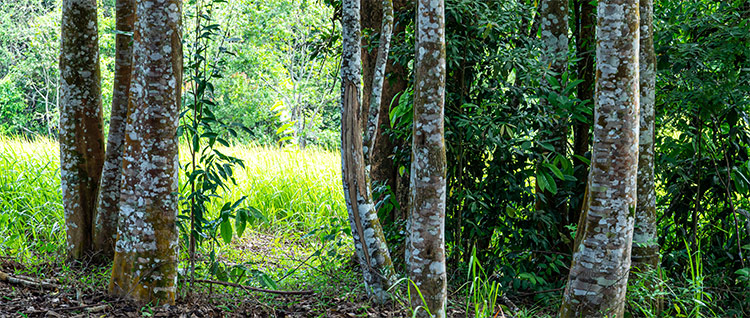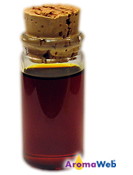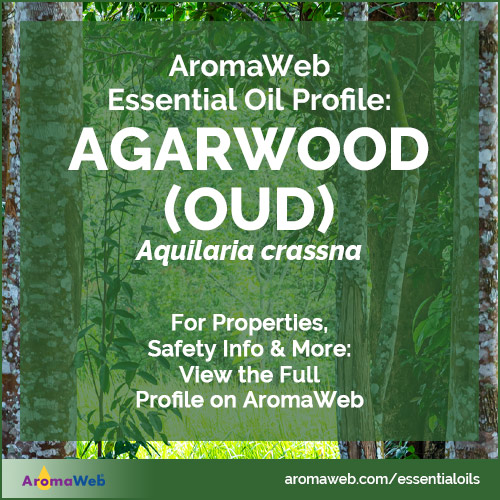Agarwood Essential Oil
Aquilaria crassna

Description
Agarwood Essential Oil is also known as Oud Essential Oil.
In various areas of the world, the tree is known as agar, oud, ood, aloes wood, eaglewood, gahuru and jinkoh.
Agarwood Essential Oil is one of the most costly of essential oils. It is primarily used within the scope of perfumery and spirituality applications. Historically, the wood has also been harvested and sold for use in incense applications.
References to agarwood and incense made out of agarwood are found in many Biblical, religious and spiritual texts.
Example Reference: "Your plants are an orchard of pomegranates with choices fruits, with henna and nard, nard and saffron, calamus and cinnamon, with every kind of incense tree, with myrrh and aloes [aloeswood / agarwood] and all the finest spices." — Song of Songs 5:13-14 (NIV)
The genus Aquilaria belongs to the Thymelaeaceae plant family. Although there are multiple agar tree species that fall within the Aquilaria genus, the specific species that I am finding as commercially available from reputable suppliers in small quantities is Aquilaria crassna sourced primarily from Thailand. It is this species that I am specifically describing within this profile.
To produce a quality Agarwood Essential Oil, the wood of the agar tree must develop a fungal infection. The infection causes the tree to defend itself. As a part of its defense mechanism, the tree produces a dark resin that leads to the highly desirable, characteristic aroma and properties of agarwood. This process can take numerous years. If the wood was harvested and distilled from an agar tree that was not infected, the oil would lack the desirable aroma and properties sought after in Agarwood Oil.
Undiluted Agarwood Essential Oil is dark in color and possesses a bold, tenacious aroma that is heavily woody and earthy in character. The aroma of Agarwood Oil is best appreciated in low dilutions.
The molecular components identified in Agarwood Essential Oil consist primarily of sesquiterpenols, ketones and sesquiterpenes. It is comprised of many components that are not widely identified within other essential oils commonly available commercially. When the oil undergoes analysis via GC/MS or GC/FID, many constituents are typically left unidentified.
The abundance of sesquiterpenols and its complex, tenacious aroma makes Agarwood Essential Oil well suited for use within spiritual, religious and perfumery applications.
Agarwood Essential Oil is a base note that is especially grounding, and it helps to provide a sense of calm.
Agarwood Essential Oil sourced from Aquilaria crassna is critically endangered, and many of the other trees in the Aquilaria genus are either endangered or critically endangered. When possible, consider using an alternative essential oil for your needs.
When shopping for the oil, look for Agarwood Oil sourced from suppliers that describe the sustainability practices used in the harvestation and distillation of the oil. Oil that is distilled from plantation farmed trees instead of from overharvested forests helps to reduce endangerment. See the Sustainability and Conservation Status section below for more information.
When choosing to purchase and use Agarwood Essential Oil, it's crucial that your oil is purchased from a highly reputable supplier to ensure that the supplier sells Agarwood Essential Oil that is sustainably sourced and also so that you can trust the authenticity of the costly oil that you are purchasing.
Some reputable essential oil suppliers offer Agarwood Essential Oil pre-diluted in a carrier oil to help minimize cost. Look to the suppliers' product detail pages to learn what ratio the oil has been diluted and into what carrier. (I should clarify that I am not speaking of the unscrupulous practice by some shady sellers of diluting or blending essential oils without disclosing this to their customers. Instead, I am speaking of reputable sellers that offer rare, costly and/or endangered essential oils in a pre-diluted form with full disclosure so that buyers can experience an essential oil that buyers may otherwise not be able to experience.)

Agarwood Essential Oil Benefits and Uses
- Spirituality
- Chakra Balancing
- Subtle Aromatherapy
- Perfumery and Fragrancing
Botanical Name
Plant Family
Common Method of Extraction
Steam or Hydro Distilled
Plant Part Typically Used
Color
Dark Brown
Consistency
Thick
Perfumery Note
Base
Strength of Initial Aroma
Strong
Aromatic Description
Agarwood Essential Oil has a complex aromatic profile. It smells earthy, woody and slightly smokey. It features a tenacious distinctive aroma that is considered unpleasant by some when smelled at full strength. The aroma shines when it is diluted significantly or blended in a small percentage with other aromatics.
Sustainability and Conservation Status
Critically Endangered
Source: https://www.iucnredlist.org/species/32814/2824513
To learn more about the conservation status of essential oil bearing plants and how to use the IUCN Red List of Threatened Species, please refer to AromaWeb's Guide to Essential Oils and Sustainability.
Major Constituents
- Valerianol
- alpha-Eudesmol
- beta-Eudesmol
- gamma-Eudesmol
- 10-epi-gamma-Eudesmol
- Dehydrofukinone
Source: A study of Agarwood Essential Oil GC-MS and GC-FID Analysis Reports as available during August, 2023 via Aromatics International, Lotus Garden Botanicals, Nature's Gift and Stillpoint Aromatics.
Agarwood Essential Oil Safety Information
Because of how costly Agarwood Oil is, it is at greater risk of adulteration. Therefore, great care must be used to ensure that you acquire the oil from a trusted source (see the introduction to this profile for more info). Any adulterated oil can be at greater risk for unknown safety contraindications. For authentic Agarwood Essential Oil, Tisserand and Young do not indicate any special precautions. However, the profile that appears within the second edition of Essential Oil Safety does not include the species Aquilaria crassna which is the species presently available commercially in limited quantities. Reading Tisserand and Young's full profile is recommended. [Robert Tisserand and Rodney Young, Essential Oil Safety (Second Edition. United Kingdom: Churchill Livingstone Elsevier, 2014), 190.]
Agarwood Essential Oil References
- Steffen Arctander, Perfume and Flavor Materials of Natural Origin (Reprint Edition. Elizabeth, NJ: Pathfinder., 2017), 49.
- Salvatore Battaglia, The Complete Guide to Aromatherapy Third Edition Volume 3 - Psyche & Subtle (Brisbane Australia: Black Pepper Creative, 2021), 96-98.
- Tony Burfield, Natural Aromatic Materials: Odours & Origins, Second Edition (Tampa, FL: The Atlantic Institute of Aromatherapy, 2016), 192-202.
- Robert Tisserand and Rodney Young, Essential Oil Safety (Second Edition. United Kingdom: Churchill Livingstone Elsevier, 2014), 190.
General Safety Information
Do not take any oils internally and do not apply undiluted essential oils, absolutes, CO2s or other concentrated essences onto the skin without advanced essential oil knowledge or consultation from a qualified aromatherapy practitioner. For general dilution information, read AromaWeb's Guide to Diluting Essential Oils. If you are pregnant, epileptic, have liver damage, have cancer, or have any other medical problem, use oils only under the proper guidance of a qualified aromatherapy practitioner. Use extreme caution when using oils with children and be sure to first read the recommended dilution ratios for children. Consult a qualified aromatherapy practitioner before using oils with children, the elderly, if you have medical issues or are taking medications. Before using this or any essential oil, carefully read AromaWeb's Essential Oil Safety Information page. For in-depth information on oil safety issues, read Essential Oil Safety by Robert Tisserand and Rodney Young.
Shelf Life
Important Information About the Profiles
The essential oil information provided on AromaWeb is intended for basic educational purposes only. The references to safety information, test results, constituents and percentages is generalized information. Essential oils can vary greatly in composition. The data is not necessary complete and is not guaranteed to be accurate. The essential oil photos are intended to represent the typical and approximate color of each essential oil. However, essential oil composition and color can vary based on harvesting, distillation, age of the essential oil and other factors. Profiles for several CO2 Extracts and absolutes are included within the directory, and are denoted as such.
